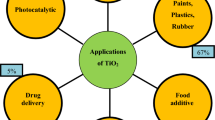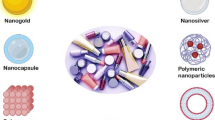Abstract
Nanoparticles agglomerate when in contact with biological solutions, depending on the solutions’ nature. The agglomeration state will directly influence cellular response, since free nanoparticles are prone to interact with cells and get absorbed into them. In sunscreens, titanium dioxide nanoparticles (TiO2-NPs) form mainly aggregates between 30 and 150 nm. Until now, no toxicological study with skin cells has reached this range of size distribution. Therefore, in order to reliably evaluate their safety, it is essential to prepare suspensions with reproducibility, irrespective of the biological solution used, representing the above particle size distribution range of NPs (30–150 nm) found on sunscreens. Thus, the aim of this study was to develop a unique protocol of TiO2 dispersion, combining these features after dilution in different skin cell culture media, for in vitro tests. This new protocol was based on physicochemical characteristics of TiO2, which led to the choice of the optimal pH condition for ultrasonication. The next step consisted of stabilization of protein capping with acidified bovine serum albumin, followed by an adjustment of pH to 7.0. At each step, the solutions were analyzed by dynamic light scattering and transmission electron microscopy. The final concentration of NPs was determined by inductively coupled plasma-optical emission spectroscopy. Finally, when diluted in dulbecco’s modified eagle medium, melanocytes growth medium, or keratinocytes growth medium, TiO2–NPs displayed a highly reproducible size distribution, within the desired size range and without significant differences among the media. Together, these results demonstrate the consistency achieved by this new methodology and its suitability for in vitro tests involving skin cell cultures.







Similar content being viewed by others
References
22412:2008 I (2008) Particle size analysis—Dynamic light scattering (DLS)
Allouni ZE, Cimpan MR, Hol PJ, Skodvin T, Gjerdet NR (2009) Agglomeration and sedimentation of TiO2 nanoparticles in cell culture medium. Colloids Surf B Biointerfaces 68:83–87. doi:10.1016/j.colsurfb.2008.09.014
Brant J, Lecoanet H, Wiesner MR (2005) Aggregation and deposition characteristics of fullerene nanoparticles in aqueous systems. J Nanopart Res 7:545–553. doi:10.1007/s11051-005-4884-8
Brun E et al (2014) Titanium dioxide nanoparticle impact and translocation through ex vivo, in vivo and in vitro gut epithelia. Part fibre toxicol 11:13
Butler MK, Prow TW, Guo YN, Lin LL, Webb RI, Martin DJ (2012) High-pressure freezing/freeze substitution and transmission electron microscopy for characterization of metal oxide nanoparticles within sunscreens. Nanomedicine (Lond) 7:541–551. doi:10.2217/nnm.11.149
Carrière M, Pigeot-Rémy S, Casanova A, Dhawan A, Lazzaroni J-C, Guillard C, Herlin-Boime N (2014) Impact of Titanium dioxide nanoparticle dispersion state and dispersion method on their toxicity towards a549 lung cells and escherichia coli bacteria. J Transl Toxicol 1:10–20
Chaudhry Q, Scientific Committee S (2015) Revision of the opinion on Titanium dioxide, nano form. Regul Toxicol Pharmacol. doi:10.1016/j.yrtph.2015.09.005
Gamer AO, Leibold E, van Ravenzwaay B (2006) The in vitro absorption of microfine zinc oxide and titanium dioxide through porcine skin. Toxicol In Vitro 20:301–307. doi:10.1016/j.tiv.2005.08.008
Guiot C, Spalla O (2013) Stabilization of TiO2 nanoparticles in complex medium through a pH adjustment protocol. Environ Sci Technol 47:1057–1064. doi:10.1021/es3040736
Halász G, Gyüre B, Jánosi IM, Szabó KG, Tél T (2007) Vortex flow generated by a magnetic stirrer. Am J Phys 75:1092–1098
Henkler F et al (2012) Risk assessment of nanomaterials in cosmetics: a European union perspective. Arch Toxicol 86:1641–1646. doi:10.1007/s00204-012-0944-x
Hunter RJ (1981) Zeta potential in colloid science: principles and applications. Colloid Science. Academic Press Inc., London
Iavicoli I, Leso V, Fontana L, Bergamaschi A (2011) Toxicological effects of titanium dioxide nanoparticles: a review of in vitro mammalian studies. Eur Rev Med Pharmacol Sci 15:481–508
ISO 14887 (2000) Sample preparation—dispersing procedures for powders in liquids
Ji Z et al (2010) Dispersion and stability optimization of TiO2 nanoparticles in cell culture media. Environ Sci Technol 44:7309–7314. doi:10.1021/es100417s
Jiang J, Oberdörster G, Biswas P (2009) Characterization of size, surface charge, and agglomeration state of nanoparticle dispersions for toxicological studies. J Nanopart Res 11:77–89
Kermanizadeh A et al (2013) An in vitro assessment of panel of engineered nanomaterials using a human renal cell line: cytotoxicity, pro-inflammatory response, oxidative stress and genotoxicity. BMC Nephrol 14:96. doi:10.1186/1471-2369-14-96
Kiss B et al (2008) Investigation of micronized titanium dioxide penetration in human skin xenografts and its effect on cellular functions of human skin-derived cells. Exp Dermatol 17:659–667. doi:10.1111/j.1600-0625.2007.00683.x
Kopac T, Bozgeyik K (2010) Effect of surface area enhancement on the adsorption of bovine serum albumin onto titanium dioxide colloids and surfaces B. Biointerfaces 76:265–271. doi:10.1016/j.colsurfb.2009.11.002
Kosmulski M (2002) The significance of the difference in the point of zero charge between rutile and anatase. Adv Colloid Interface Sci 99:255–264
Mavon A, Miquel C, Lejeune O, Payre B, Moretto P (2007) In vitro percutaneous absorption and in vivo stratum corneum distribution of an organic and a mineral sunscreen. Skin Pharmacol Physiol 20:10–20. doi:10.1159/000096167
Murdock RC, Braydich-Stolle L, Schrand AM, Schlager JJ, Hussain SM (2008) Characterization of nanomaterial dispersion in solution prior to in vitro exposure using dynamic light scattering technique. Toxicol Sci 101:239–253. doi:10.1093/toxsci/kfm240
Othman SH, Abdul Rashid S, Mohd Ghazi TI, Abdullah N (2012) Dispersion and stabilization of photocatalytic TiO2 nanoparticles in aqueous suspension for coatings applications. J Nanomater 2012:10. doi:10.1155/2012/718214
Prasad RY et al (2013) Effect of treatment media on the agglomeration of titanium dioxide nanoparticles: impact on genotoxicity, cellular interaction, and cell cycle. ACS Nano 7:1929–1942. doi:10.1021/nn302280n
Roco MC (1999) Nanoparticles and nanotechnology research. J Nanopart Res 1:1–6
Schilling K et al (2010) Human safety review of “nano” Titanium dioxide and Zinc oxide. Photochem Photobiol Sci 9:495–509. doi:10.1039/b9
Schulz J et al (2002) Distribution of sunscreens on skin. Adv Drug Deliv Rev 54(Suppl 1):S157–S163
Shi H, Magaye R, Castranova V, Zhao J (2013) Titanium dioxide nanoparticles: a review of current toxicological data. Part Fibre Toxicol 10:15. doi:10.1186/1743-8977-10-15
Song L, Yang K, Jiang W, Du P, Xing B (2012) Adsorption of bovine serum albumin on nano and bulk oxide particles in deionized water Colloids and surfaces B. Biointerfaces 94:341–346. doi:10.1016/j.colsurfb.2012.02.011
Suttiponparnit K, Jiang J, Sahu M, Suvachittanont S, Charinpanitkul T, Biswas P (2011) Role of surface area, primary particle size, and crystal phase on titanium dioxide nanoparticle dispersion properties. Nanoscale Res Lett 6:1–8
Taurozzi JS, Hackley VA, Wiesner MR (2012) Preparation of nanoparticle dispersions from powdered material using Ultrasonic Disruption NanoEHS Protocols. NIST Spec Publ 1200:2
Taurozzi J, Hackley V, Wiesner M (2013a) Preparation of nanoparticle dispersions from powdered material using ultrasonic disruption
Taurozzi JS, Hackley VA, Wiesner MR (2013b) A standardised approach for the dispersion of titanium dioxide nanoparticles in biological media Nanotoxicology 7:389–401
Tucci P et al (2013) Metabolic effects of TiO2 nanoparticles, a common component of sunscreens and cosmetics, on human keratinocytes. Cell Death Dis 4(3):e549. doi:10.1038/cddis.2013.76
Tyner KM, Wokovich AM, Godar DE, Doub WH, Sadrieh N (2011) The state of nano-sized titanium dioxide (TiO2) may affect sunscreen performance. Int J Cosmet Sci 33:234–244. doi:10.1111/j.1468-2494.2010.00622.x
Wang SQ, Tooley IR (2011) Photoprotection in the era of nanotechnology. Semin Cutan Med Surg 30:210–213. doi:10.1016/j.sder.2011.07.006
Widegren J, Bergstrom L (2002) Electrostatic stabilization of ultrafine titania in ethanol. J Am Ceram Soc 85:523–528
Wu W et al (2014) Dispersion method for safety research on manufactured nanomaterials. Ind Health 52:54–65
Xiong S, George S, Yu H, Damoiseaux R, France B, Ng KW, Loo JS (2013) Size influences the cytotoxicity of poly (lactic-co-glycolic acid) (PLGA) and titanium dioxide (TiO(2)) nanoparticles. Arch Toxicol 87:1075–1086. doi:10.1007/s00204-012-0938-8
Zhang X, Yin L, Tang M, Pu Y (2010) Optimized method for preparation of TiO2 nanoparticles dispersion for biological study. J Nanosci Nanotechnol 10:5213–5219
Zhang X, Li W, Yang Z (2015) Toxicology of nanosized titanium dioxide: an update. Arch Toxicol. doi:10.1007/s00204-015-1594-6
Zhao Y, Howe JL, Yu Z, Leong DT, Chu JJ, Loo JS, Ng KW (2013) Exposure to titanium dioxide nanoparticles induces autophagy in primary human keratinocytes. Small 9:387–392. doi:10.1002/smll.201201363
Acknowledgments
This work was supported by grants from the CNPq/PROMETRO, and the CNPq/PVE—CIÊNCIA SEM FRONTEIRAS. We would like to acknowledge the financial support of the National Institute of Metrology Quality and Technology for the Post-Doctoral (52600.017263/2013) scholarship.
Author information
Authors and Affiliations
Corresponding author
Additional information
Karina Penedo Carvalho and Nathalia Balthazar Martins have contributed equally to this work.
Electronic supplementary material
Below is the link to the electronic supplementary material.
Rights and permissions
About this article
Cite this article
Carvalho, K.P., Martins, N.B., Ribeiro, A.R.L.P. et al. Optimized method of dispersion of titanium dioxide nanoparticles for evaluation of safety aspects in cosmetics. J Nanopart Res 18, 244 (2016). https://doi.org/10.1007/s11051-016-3542-7
Received:
Accepted:
Published:
DOI: https://doi.org/10.1007/s11051-016-3542-7




